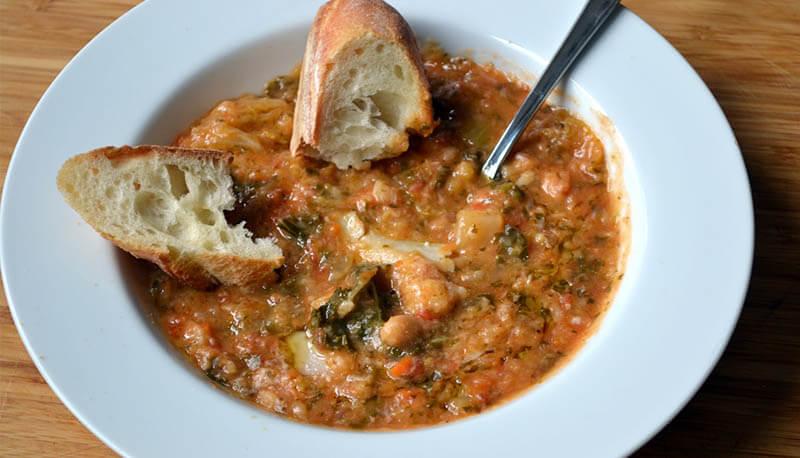Concetti Chiave
- Ribollita is a traditional Tuscan soup that varies by season and region but must contain beans, savoy cabbage, and black cabbage.
- The soup is rooted in the farming tradition, typically made by reheating leftovers with stale bread and olive oil.
- Key ingredients include black cabbage, savoy cabbage, potatoes, carrots, onion, cherry tomatoes, zucchinis, celery, Cannellini beans, pureed tomatoes, and Tuscan stale bread.
- The preparation involves simmering beans, sautéing vegetables, and layering them with bread in a terracotta pan, then serving hot.
- Ribollita is a winter favorite, known for its rich flavors and hearty texture, making it a staple of Tuscan peasant cuisine.
In questo appunto di civiltà inglese viene riportata in lingua inglese una ricetta relativa alla preparazione della ribollita toscana. Vengono riportati gli aspetti principali sulla preparazione della ribollita, con indicata tutta la preparazione stessa della classica ricetta. Sono riportati anche tutti gli ingredienti della stessa ricetta descritti uno ad uno.
Indice
Ribollita
Ribollita is a tipycal Tuscan soup vegetables - based.It derives from the farming tradition, this Tuscan regional recipe is always in.
Its composition changes depending on the season and on the available vegetables, and it remains a classic of paesant cuisine, above all in winter.
Its name take the cue from the necessity of cooking it at length and of “boil it” over and over again. According to tradition it has to be made on Friday night, putting together all the remains of the previous days and baking them again with stale bread and oil.
There is not only one version of Ribollita, every Tuscan area has its modifications, but the basic rule is only one: to be called Ribollita has to contain beans, savoy and black cabbage.
Ingredients
- 1 black cabbage
- 1/2 savoy cabbage
- potatoes
- 2 carrots
- An onion
- 10 cherry tomatoes
- 2 zucchinis
- 1 branch of celery (and its leaves)
- 400 grams of Cannellini beans
- A jar of pureed tomatos
- Extra-virgin olive oil
- Tuscan stale bread
Procedure
Place the unsoaked dried beans in the smaller pot with 4 cups of cold water and just ½ teaspoon of salt. Turn on the heat to medium and bring to a gentle boil, then turn down the heat to the lowest setting and cover with a lid. Keep simmering until cooked (between 3- and 3 ½ hours in my experience). Otherwise use soaked beans and cook them in the same amount of water, until done (cooking time will be quicker).Meanwhile, brown the sliced onion in a large pot, add sliced carrot and the cubed celery too, then wait until golden in color.
Stir often to avoid burning. Five minutes later put chopped cherry tomatoes and let them cook over medium-high heat for ten minutes, covered.
Lower the flame and add diced potatoes.
Ten minutes later, add divided savoy and black cabbage.
Now you have to put 1/2 beans in the pan and after a while, diced zucchinis too.
Puree the rest of the beans and add pureed tomatos. When the mixture is good, put it with the vegetables.
Slice the stale bread in pieces and make it bake in the oven.
Take a terracotta pan and place the stale bread at the bottom.
Pour the vegetables with the broth and then put other bread.
Add vegetables and broth again, then flavor with a drizzle of olive oil.
Serve Ribollita very, very hot!
Vedi anche altre ricette in lingua inglese:
Roasted chicken (Marengo)
Hot chocolate pudding
Recipe - Spaghetti alla chitarra
Domande da interrogazione
- Qual è l'origine della ribollita toscana?
- Quali sono gli ingredienti essenziali per preparare la ribollita?
- Come si prepara la ribollita secondo la tradizione?
- Qual è la particolarità del nome "ribollita"?
La ribollita è una zuppa tipica toscana che deriva dalla tradizione contadina, preparata con verdure di stagione e pane raffermo.
Gli ingredienti essenziali includono fagioli, cavolo nero, cavolo verza, patate, carote, cipolla, pomodori ciliegini, zucchine, sedano, passata di pomodoro, olio extravergine d'oliva e pane toscano raffermo.
La ribollita si prepara cuocendo a lungo le verdure e i fagioli, poi si aggiunge il pane raffermo e si fa ribollire il tutto più volte, servendola molto calda.
Il nome "ribollita" deriva dalla necessità di cuocere la zuppa a lungo e di farla "ribollire" più volte, utilizzando gli avanzi dei giorni precedenti.






 Accedi a tutti gli appunti
Accedi a tutti gli appunti
 Tutor AI: studia meglio e in meno tempo
Tutor AI: studia meglio e in meno tempo